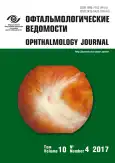Personalized analysis of foveal avascular zone with optical coherence tomography angiography
- Authors: Burnasheva M.A.1, Kulikov A.N.1, Maltsev D.S.1
-
Affiliations:
- S.M. Kirov Military Medical Academy
- Issue: Vol 10, No 4 (2017)
- Pages: 32-40
- Section: Articles
- URL: https://journals.rcsi.science/ov/article/view/7786
- DOI: https://doi.org/10.17816/OV10432-40
- ID: 7786
Cite item
Abstract
Aim. To investigate the relationship between the foveal avascular zone (FAZ) and inner nuclear layer (INL) – free zone in order to provide a personalized approach for evaluation of the FAZ area with optical coherence tomography-angiography (OCTA).
Material and methods.Thirty-six healthy individuals (36 eyes) and 9 patients (12 eyes) with nonproliferative diabetic retinopathy (nPDR) were included in this study. The FAZ area as well as INL-free zone were measured in superficial capillary plexus on OCTA images. The FAZ area, INL-free area, and the ratio of the INL-free area to the FAZ area were compared between healthy subjects and nPDR patients.
Results. The mean FAZ area in healthy subjects and nPDR patients was 0.33 ± 0.1 and 0.56 ± 0.28 mm2 (p < 0.05), respectively. The mean INL-free zone in healthy subjects and nPDR patients was 0.33 ± 0.07 and 0.28 ± 0.1 mm2 (p > 0.05), respectively. The ratio of the INL-free area to the FAZ area in healthy subjects and nPDR patients was 1.08 ± 0.25 and 0.57 ± 0.2 (p < 0.001), respectively. Receiver operating characteristic analysis showed that the ratio of the INL-free area to the FAZ area had the higher area under curve (0.98; 91.7% sensitivity and 97.2% specificity) compared to the FAZ area (0.8; 66.7% sensitivity and 87.1% specificity) for differentiating nPDR from healthy eyes.
Conclusion. This study showed that personalized analysis of the FAZ area based on the relationship between the actual FAZ and INL-free zone has better diagnostic accuracy compared to the conventional FAZ area measurement on OCTA images.
Full Text
##article.viewOnOriginalSite##About the authors
Maria A. Burnasheva
S.M. Kirov Military Medical Academy
Author for correspondence.
Email: maria.andreevna1@gmail.com
MD, resident of the ophthalmology department
Russian Federation, Saint PetersburgAlexey N. Kulikov
S.M. Kirov Military Medical Academy
Email: alexey.kulikov@mail.ru
MD, PhD, DSc, assistant professor, head of the ophthalmology department
Russian Federation, Saint PetersburgDmitrii S. Maltsev
S.M. Kirov Military Medical Academy
Email: glaz.med@yandex.ru
MD, PhD, ophthalmologist of the ophthalmology department
Russian Federation, Saint PetersburgReferences
- Тульцева С.Н., Астахов Ю.С., Руховец А.Г., Титаренко А.И. Информативность ОКТ-ангиографии в сочетании с исследованиями регионарной гемодинамики при окклюзии вен сетчатки // Офтальмол. ведомости. – 2017. – Т. 10. – № 2. – С. 40–48. [Tultseva SN, Astakhov YS, Rukhovets AG, Titarenko AI. Diagnostic value of OCT-angiography and regional hemodynamic assessment in patients with retinal vein occlusion. Ophthalmology Journal. 2017;10(2):40-48. (In Russ.)]. doi: 10.17816/OV10240-48.
- Campbell JP, Zhang M, Hwang TS, et al. Detailed vascular anatomy of the human retina by projection-resolved optical coherence tomography angiography. Sci Rep. 2017;7:42201. doi: 10.1038/srep42201.
- Chui TY, Van Nasdale DA, Elsner AE, Burns SA. The association between the foveal avascular zone and retinal thickness. Invest Ophthalmol Vis Sci. 2014;55(10):6870-7.
- Chui TY, Zhong Z, Song H, Burns SA. Foveal avascular zone and its relationship to foveal pit shape. Optom Vis Sci. 2012;89:602-10. doi: 10.1097/OPX.0b013e3182504227.
- Dubis AM, Hansen BR, Cooper RF, et al. Relationship between the foveal avascular zone and foveal pit morphology. Invest Ophthalmol Vis Sci. 2012;53:1628-1636. doi: 10.1167/iovs.11-8488.
- Jia Y, Bailey ST, Hwang TS, et al. Quantitative optical coherence tomography angiography of vascular abnormalities in the living human eye. Proc Natl Acad Sci USA. 2015;112(18): E2395-402.
- Kumagai K, Furukawa M, Suetsugu T, Ogino N. Foveal avascular zone area after internal limiting membrane peeling for epiretinal membrane and macular hole compared with that of fellow eyes and healthy controls. Retina. 2017; Aug1. [Epub ahead of print].
- Krawitz BD, Mo S, Geyman LS, et al. Acircularity index and axis ratio of the foveal avascular zone in diabetic eyes and healthycontrols measured by optical coherence tomography angiography. Vision Res. 2017. pii: S0042-6989(17)30019-6.
- Nesper PL, Roberts PK, Onishi AC, et al. Quantifying microvascular abnormalities with increasing severity of diabetic retinopathy using optical coherence tomography angiography. Invest Ophthalmol Vis Sci. 2017;58(6): BIO307-BIO315.
- Park JJ, Soetikno BT, Fawzi AA. Characterization of the middle capillary plexus using optical coherence tomography angiography in healthy and diabetic eyes. Retina. 2016;36(11):2039-2050. doi: 10.1097/IAE.0000000000001077.
- Samara WA, Say EA, Khoo CT, et al. Correlation of foveal avascular zone size with foveal morphology in normal eyes using optical coherence tomography angiography. Retina. 2015Nov;35(11):2188-95. doi: 10.1097/IAE.0000000000000847.
- Savastano MC, Lumbroso B, Rispoli M. In vivo characterization of retinal vascularization morphology using optical coherence tomography angiography. Retina. 2015;35(11):2196-203. doi: 10.1097/IAE.0000000000000635.
- Sun JK, Lin MM, Lammer J, et al. Disorganization of the retinal inner layers as a predictor of visual acuity in eyes with center-involved diabetic macular edema. JAMA Ophthalmol. 2014;132(11):1309-16.
Supplementary files












